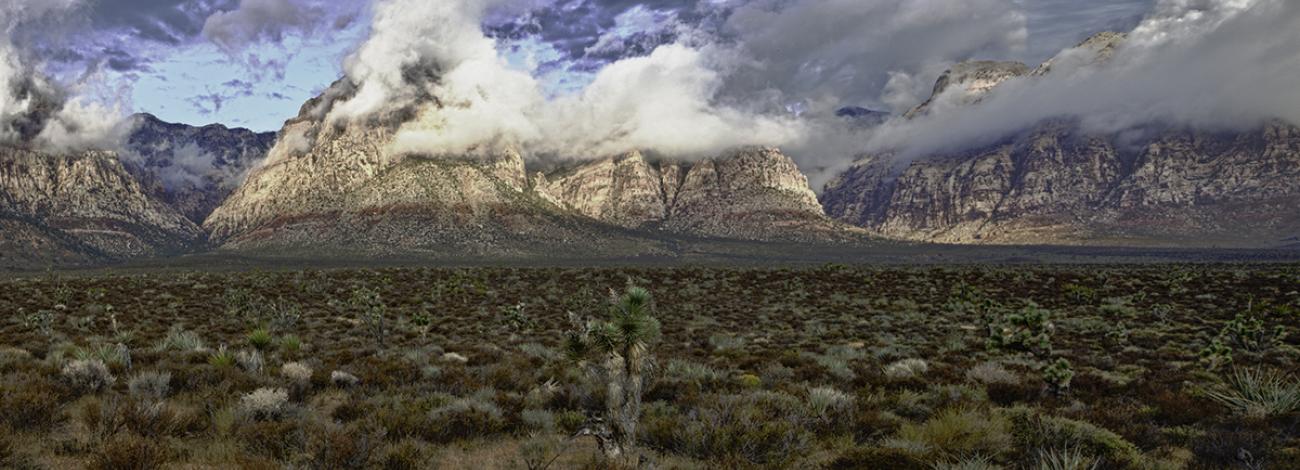
Red Rock Canyon National Conservation Area
Timed entry reservations are required for the Scenic Drive between October 1 - May 31 for entry between 8 a.m. - 5 p.m. Timed entry reservations can be made at Recreation.gov by visiting https://www.recreation.gov/timed-entry/10075177, or by calling (877) 444-6777.
Red Rock Canyon was designated as Nevada's first National Conservation Area. Red Rock Canyon is located 17 miles west of the Las Vegas Strip on Charleston Boulevard/State Route 159. In marked contrast to a town geared to entertainment and gaming, Red Rock offers enticements of a different nature including a 13-mile scenic drive, miles of hiking trails, rock climbing, horseback riding, mountain biking, road biking, picnic areas, nature observing and visitor center with indoor and outdoor exhibits as well as a book store.
In 1990, special legislation supported by the Nevada congressional delegation, changed the status of the Red Rock Recreation Lands to a National Conservation Area, the seventh to be designated nationally. This legislation provides the funding to protect and improve the area. Red Rock Canyon National Conservation Area is enjoyed by the local population as well as visitors from the United States and many foreign countries. More than three million visitors each year enjoy the spectacular desert landscape, climbing and hiking opportunities, and interpretive programs sponsored by the BLM.
The BLM is the largest administrator of public lands in the West. It adheres to the policy of multiple use, thereby providing recreational opportunities, protection for cultural sites, and the management of natural resources, including wildlife.
- Driving Directions
-
Red Rock Canyon National Conservation Area is only 30 minutes from the Las Vegas Strip. If you are using a GPS unit, please type in Red Rock Canyon Visitor Center, or 3205 State Highway 159, Las Vegas, NV 89161.
Public transportation does not extend to Red Rock Canyon. Tour buses and commercial tours may be available from your hotel.
Driving Directions from the Las Vegas Strip south of Russell Road:
- Get on to the I-15 south
- Take exit 36 for Russell Road/215 west
- Keep left at the fork, follow signs for Interstate 15 south
- Keep right at the fork, follow signs for 215 west and merge onto 215 west for 13.5 miles
- Take exit 26 for Charleston Boulevard and turn left
- Continue onto State Route 159/ West Charleston Boulevard for 5.5 miles
- Turn right into the entrance of Red Rock Canyon National Conservation Area
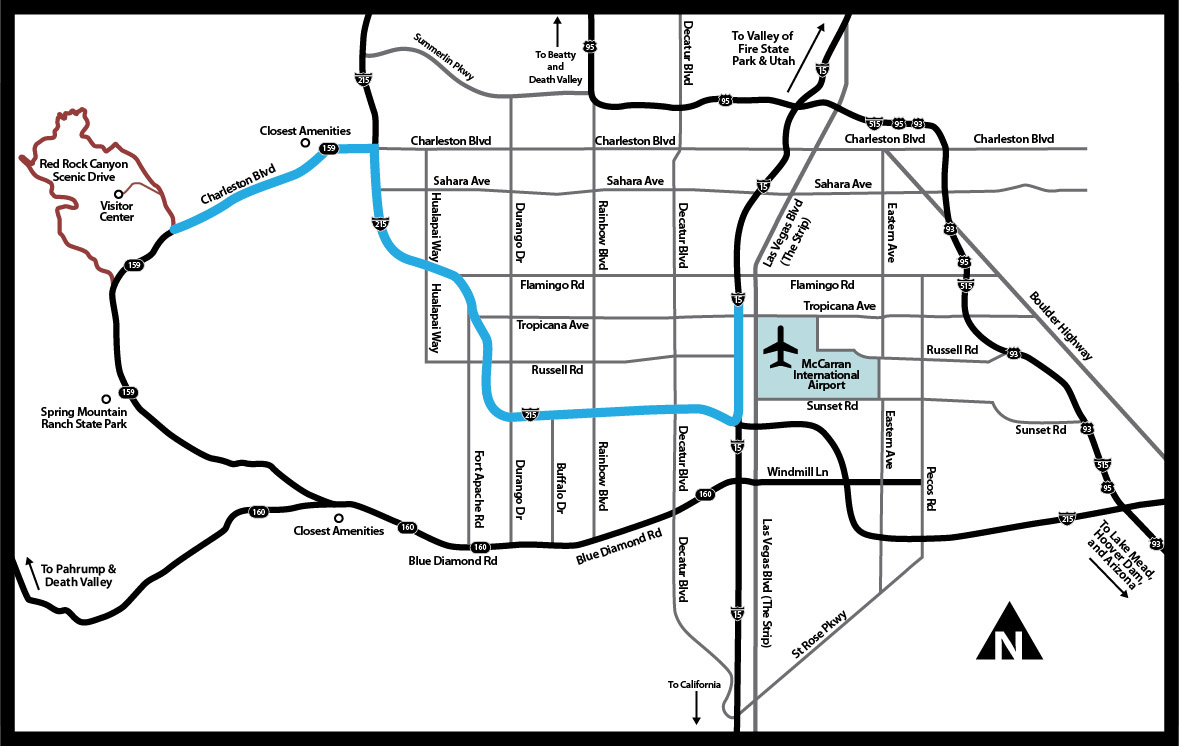
Driving Directions from the Las Vegas Strip north of Russell Road:
- Get on to the I-15 north
- Take exit 42A to merge onto US-95 north toward Reno for 6.8 miles
- Take exit 81A toward Summerlin Parkway and drive west for 6.5 miles
- The freeway will end, exit right to get on to 215 south for 3.5 miles
- Take exit 26 for Charleston Boulevard/State Route 159 for 5.5 miles
- Turn right into the entrance of Red Rock Canyon National Conservation Area
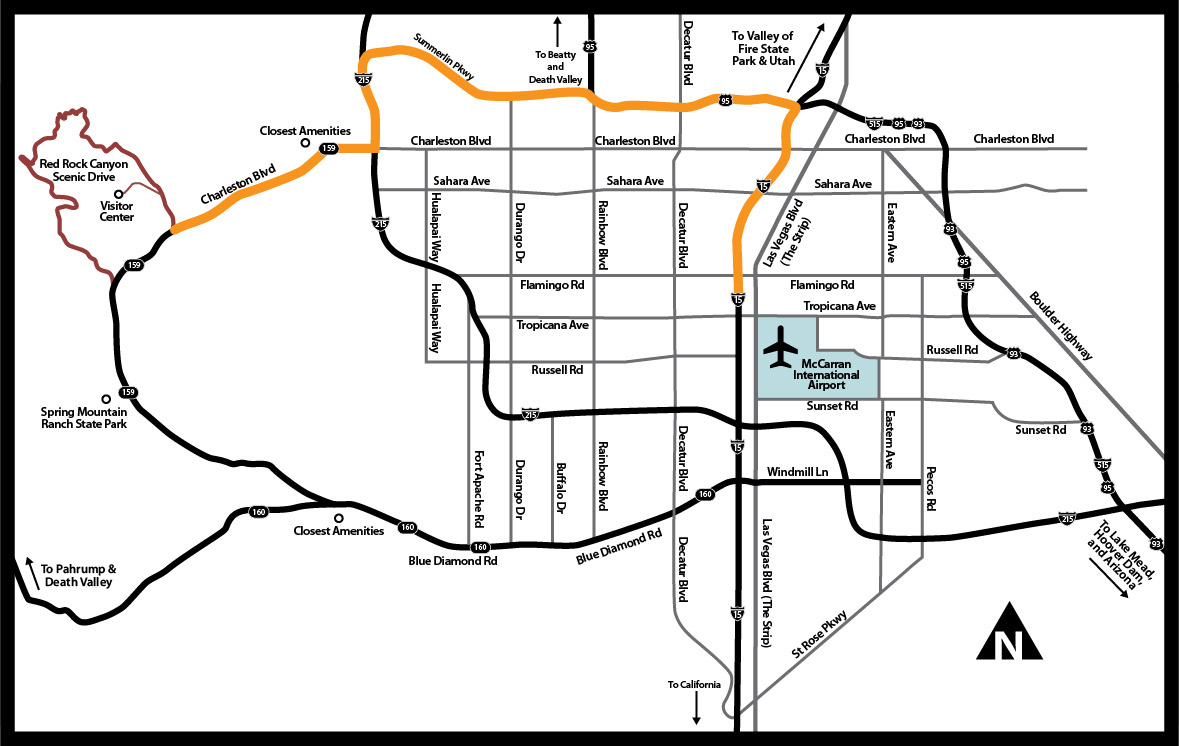
Driving Directions from State Route 160
- Get on to the I-15
- Take exit 33 toward State Route160 west /Blue Diamond Road
- Keep right at the fork and merge onto State Route 160 west /Blue Diamond Road for 10.5 miles
- Turn right onto State Route 159 east/Charleston Boulevard (opposite the gas station) drive for 10.5 miles
- Turn left into the entrance of Red Rock Canyon
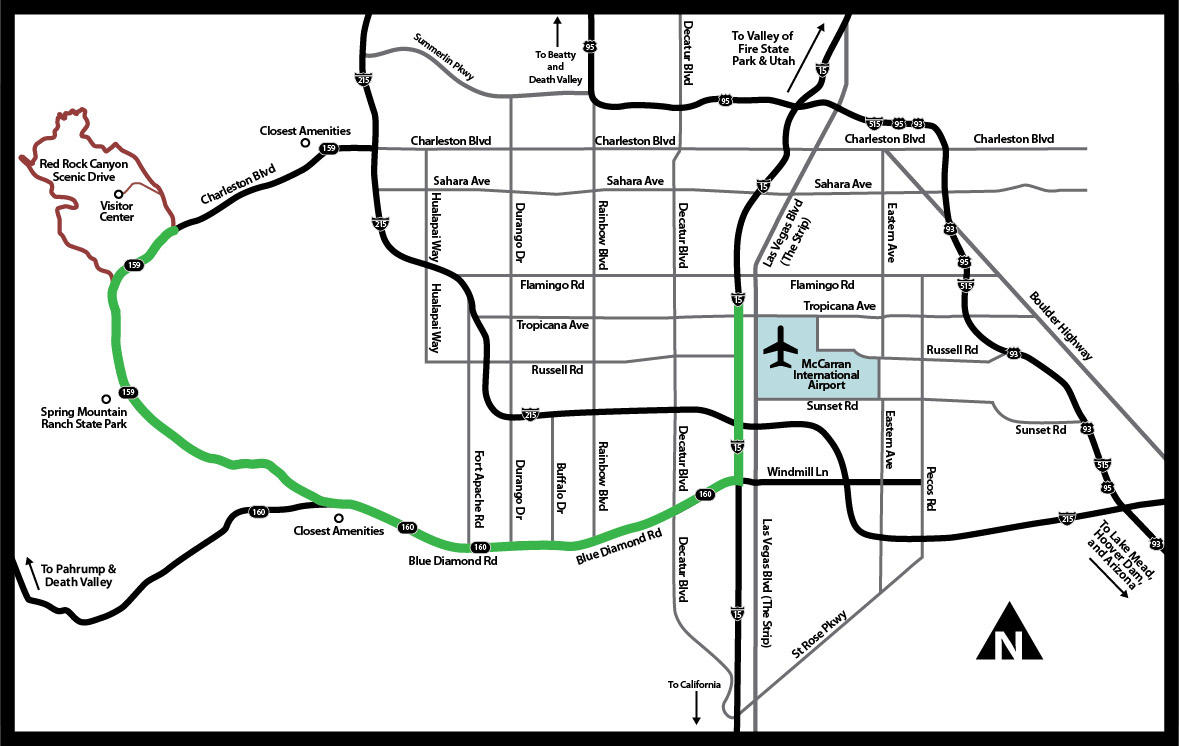
- Hours
-
13-Mile Scenic Drive
Timed entry reservations are required for the Scenic Drive between October 1 - May 31 for entry between 8 a.m. -5 p.m. Timed entry reservations can be made at Recreation.gov by visiting https://www.recreation.gov/timed-entry/10075177, or by calling (877) 444-6777.
November through February
March
April through September
October6 a.m. to 5 p.m.
6 a.m. to 7 p.m.
6 a.m. to 8 p.m.
6 a.m. to 7 p.m.* The Scenic Drive is open from 6 a.m. to noon on Thanksgiving and Christmas Day. *
Red Spring Picnic Area
November through February
March
April through September
October6 a.m. to 5 p.m.
6 a.m. to 7 p.m.
6 a.m. to 8 p.m.
6 a.m. to 7 p.m.Red Rock Overlook on State Route 159
November through February
March
April through September
October6 a.m. to 5 p.m.
6 a.m. to 7 p.m.
6 a.m. to 8 p.m.
6 a.m. to 7 p.m.Visitor Center
Daily
Thanksgiving Day
Christmas Day8 a.m. to 4:30 p.m.
8 a.m. to 12 p.m.
8 a.m. to 12 p.m.Administrative Office
Monday through Friday 8 a.m. to 4.30 p.m. Red Rock Campground
The campground typically closes for the summer months.
- Photography
-
Red Rock Canyon National Conservation Area’s scenic vistas are inspiring to many amateur and professional photographers.
Most visitors take snapshots of their visit. This is considered casual use and does not require a film permit. It is typified by an individual or group of individuals taking pictures, either still or moving, for personal use.
In some cases, permits may be required.
Still photography requires a film permit when one or more of the following situations apply:
- Use of models or props which are not part of a site’s natural or cultural resources or administrative facilities are involved.
- Family or wedding portraits taken by professional photographers would be considered use of “models” as would products placed at the site. Props include reflectors, bounce cards, sound booms, or similar equipment.
- If such photography takes place at locations where members of the public are generally not allowed.
- If it occurs where additional administrative costs are likely.
Non-commercial still photography (photographs of scenery or wildlife) does not require a film permit if none of the above criteria apply.
Moving photography (filming) requires a film permit when documentaries, television programs, feature films; advertisements, wildlife filming, or similar projects result in a commercial product.
Student filming projects do not require a filming permit as long as the activity would not adversely impact public lands. Students need to submit a proposal in writing, with verification from the educational institution that it is a required project.
Film/Photography permits need to be acquired in advance. For more information, please email [email protected] or call (702) 515-5381.
- Special Recreation Permits
-
The Red Rock Canyon National Conservation Area Special Recreation Permit (SRP) Policy is as follows:
SRP preplanning: First time SRP applicants are required to meet with an Outdoor Recreation Planner prior to submitting an application either in person or via phone. This coordination meeting will ensure a complete SRP application is submitted and will avoid unnecessary time delays and costs. The coordination meeting should occur not less than 30 days before the application is due for submission.
SRP application deadlines: SRP applications will not be accepted earlier than one year nor later than 180 days prior to the proposed use, unless waived by the Outdoor Recreation Planner. The 180-day requirement may be waived if the proposed activity has current environmental analysis and clearances and if sufficient staff is available to process the application and monitor the proposed activity. Contact the Red Rock/Sloan Canyon Field Office if you are unsure your SRP application meets this requirement.
Outright rejection of incomplete applications: A complete SRP application contains:
- The current Special Recreation Permit application typed or printed in ink and completely filled out,
- A map produced using Global Positioning Systems with transferable compatible data to the BLM computer systems (see SRP map requirements) or a pre-approved map,
- Operating/Business Plan or other information the BLM requests,
- Advance payment of estimated fees, due at the time the application is submitted (minimum of $110 or as determined by the administrative officer).
SRP Fees: SRP fees must be paid in advance of the authorized use.
- Commercial Use Fees are 3% of gross revenue or the $130 minimum annual fee, whichever is greater.
- Competitive Use Fees are $7 per person per day, 3% of gross revenue, or the $130 minimum annual fee, whichever is greater.
- Organized Use Fees are $7 per person per day or the $130 annual minimum, whichever is greater. Please refer to the 2930-1 application form for the definitions for different types of use categories. Site fees ($260) and Exclusive Use fees ($260) may also be charged in addition to the above SRP fees.
Any commercial business regardless of the number of clients/participants or if they charge a fee and wishing to do business in the Conservation Area or deliver clients, must obtain a Special Recreation Permit.
Organized groups, which do not charge any fees and are under fifteen people and not rock climbing should call to make sure no other fees are required for their activity. Please contact an outdoor recreation planner at least 180 days in advance or more.
In addition, the Scenic Drive and Visitor Center Area are considered a “Special Area.” The Interagency passes and all annual passes are not valid with Commercial or Competitive SRP’s. They also do not allow for deductions in entrance or camping fees for these uses.
Cost Recovery: In addition to the fees in the National Recreation Fee Schedule, if the BLM needs more than 50 hours of staff time to process and monitor a SRP for commercial use in any one year, we may charge a fee for recovery of the processing costs. For competitive or organized group/event use, BLM may charge a fee for recovery of costs to the agency of analysis and permit processing instead of the SRP fee if the BLM needs more than 50 hours of staff time in any one year, and we anticipate the permit fees on the fee schedule for that year will be less than the costs of processing the SRP. We will notify you in writing if you need to pay cost recovery before processing your SRP application. All work will cease on your SRP application until 80% of the required fees have been paid.
Limitations on Cost Recovery: Cost recovery charges will be limited to BLM’s cost of issuing the permit, including necessary environmental documentation, on-site monitoring, and permit enforcement. All costs, direct and indirect, related to the processing, permitting, and monitoring of a single SRP are eligible for cost recovery. This includes BLM personnel time, printing materials, depreciation costs of vehicles, miscellaneous supplies and equipment used to process and/or monitor the SRP.
SRP map requirements: All SRP applications must include a map of the proposed route or event site. If you are using areas outside of the officially designated roads or trails, you must submit SRP map(s) produced using Global Positioning Systems with transferable compatible data to the BLM computer systems. The data must be collected in UTM Zone 11 North NAD Conus 1983. This is the format of the shapefile when using the GPS. The BLM computer systems may be able to accept other datum such as NAD 27 or waypoints; however, this may delay processing your permit and will most likely require cost recovery. Non-GPS maps are not accepted unless waived by an Authorized Officer. Once the SRP application map is submitted, no changes will be authorized unless initiated by the BLM to mitigate environmental degradation or comply with Federal, State and/or local regulations. You will need to include all proposed stops, staging areas, and other additional features such as signage to the map. A detailed map for parking/staging and rest areas may also be required particularly if restrooms or other temporary structures will be required. The BLM may require a bond (see below) if the areas or routes requested may require additional re-vegetation or re-naturalization.
Operating plan/Business plan: SRP applicants are required to submit supplemental information related to the proposed activity. This information is a written explanation of the proposed activity and how you the permittee will manage the activity. Commercial use permittees may submit a business plan along with the application. This information will aid the BLM in making a decision regarding your SRP application. A well thought operating or business plan can reduce permit processing time and costs. These plans should include emergency consideration, communication plan, numbers of participants, tours, costs to participants and any other revenue streams, anticipated impacts to other users and how the permittee plans on mitigating these.
Other licenses/permits: The SRP applicant is required to provide copies of all related licenses and/or permits obtained for the proposed activity. This includes but is not limited to: Clark County Special Events Permit, Nevada Transportation Authority license, health permits, business license, written permission from private landowners, NDOT right-of-way permit, other agency permits/approvals, etc. The BLM will not authorize your use until all such related information is received no later than two weeks prior to the proposed activity.
SRP Insurance: All commercial and competitive applicants for SRPs, except vendors, must obtain a property damage, personal injury, and public liability insurance policy that BLM judges sufficient to protect the public and United States. Your policy must name the U.S. Department of Interior-Bureau of Land Management as additionally insured and stipulate that you or your insurer will notify BLM 30 days in advance of termination or modification of the policy. A valid Insurance certificate with the proposed group/companies name which is the same as the applicant must be received a minimum 30 days prior to the event or the beginning of the permit period for the SRP to be valid. Should this insurance expire during the life of the permit, it is up to the permittee to provide updated insurance certificates 30 days prior to the expiration. All permitted activities will be stopped if the insurance is not updated.
We may also require vendors, and other applicants, such as organized groups, to obtain and submit such a policy. BLM may waive the insurance requirement if we find that the vending or group activity will not cause appreciable environmental degradation or risk to human health or safety. Please include the following statement on your insurance policy: “United States Government-The Department of Interior- BLM is additionally insured.” The permittee is required to notify the department at least 30 days or more in advance of any changes, modifications, or cancellation of insurance. If this information is not on the insurance certificate, the application or permit may be suspended, or cancelled. The permittee is responsible for ensuring the BLM has the most recent copy of insurance for the permitted activity. Failing to maintain current and/or adequate insurance is grounds for immediate suspension or termination of the permit.
Minimal insurance requirements: At a minimum, the permittee shall have in force public liability insurance covering: (1) Damage to property in the amount of thirty thousand dollars ($30,000), (2) Damage per occurrence (persons, bodily injury or death) in the amount of (minimum) three hundred thousand ($300,000); and (3) A minimum annual aggregate limit of six hundred thousand ($600,000). The coverage shall extend to property damage, bodily injury, or death arising out of the permittee’s operations under the permit, including, but not limited to, the occupancy or use of the lands, structures, facilities, or equipment authorized by the permit. Liability coverage may differ depending on the type of the event. Please contact an Outdoor Recreation Planner to inquire about additional liability insurance requirements.
SRP Stipulations: Special Recreation Permit stipulations are specific responsibilities and conditions to meet management goals and objectives and to protect lands and resources and the public interest. The first sixteen General Terms are on the back of the SRP application, and supplemental stipulations are issued depending on the type of activity. Other stipulations will be issued following the interdisciplinary review of the proposed activity which are specific to your activity or event. You must comply with all stipulations in your approved Special Recreation Permit.
“Terms and Conditions” are stipulations from the U.S. Fish and Wildlife Service relating to the Biological Opinion, to which all SRP activities must conform. The Terms and Conditions are issued with the SRP stipulations and list specific requirements the permittee must fulfill for to the activity to be approved and permitted. One such stipulation is to educate your clients/ participants about the Threatened Desert Tortoise and provide documentation stating that you have provided this. A Desert Tortoise Acknowledgement form provided by the BLM is available. This form must be signed by each activity member and returned with the permit post-use report or as agreed upon by the BLM.
Stipulations may also require the permittee to provide adequate restroom facilities, trash or waste collection, communication, signage and other health and safety resources for their clients and/or the general public.
Reporting: BLM may require you to submit an end of event, monthly, quarterly, or annual post-use report to verify your charges. You must include the gross amount of all sales, donations, and value of anything of value rendered for your services. Your actual fees will be calculated depending on whether you are considered an organized group, competitive, or commercial group, whether you utilize the Special Area in the conservation area (additional $2/person/day), and if you are subject to a site($230) or exclusive site fee($230). There may be consideration for time the activity or event is not utilizing public land.
You must submit any other required paperwork with your post-use reports such as, Desert Tortoise Acknowledgement forms, certificates for weed-free hay, guide lists, and any other required documentation by the established deadline. Failure to provide these documents can jeopardize your permit validity or renewal.
Bonding: BLM may require you to submit a payment bond, cash or surety deposit, or other financial guarantee in an amount sufficient to cover your fees or defray the costs of restoration and rehabilitation of the lands affected by the permitted use. BLM will return the bonds and financial guarantees when you have complied with all permit stipulations. BLM may waive the bonding requirement if we find that your activity will not cause appreciable environmental degradation or risk to human health and safety.
Multi-year SRP: The BLM will encourage multi-year permits for a previously approved permit if the following conditions are met: a) the purpose of the permit remains unchanged, b) the approved activity site or route does not change, c) the logistical support remains unchanged, d) environmental conditions do not change significantly, e) activity remains consistent with land use plans, federal, state, local laws and regulations, f) the previous years’ permitted activity complied with the permit stipulations, g) the permittee is in good standing on all other permits, not just the Red Rock Field Office, and h) other conditions the BLM determines appropriate (ex. customer service reports, field checks, land disposal, congressional designations, etc.). The BLM will make determinations on a case-by-case basis. Approval of a multi-year permit remains at the sole discretion of the BLM, and will be utilized when appropriate.
Expedited SRP process: The BLM will continue to seek methods for increasing efficiency and reducing consumptive impacts to the government and the permittee. As technology progresses the BLM will consider adopting processes to expedite the SRP process, while maintaining conformance with laws and regulations. It is not proposed to short-cut any process steps nor circumvents any required review time for SRP proposals.
Limited Commercial Permits: There are limits to the number of commercial use, competitive or organized group permits available as established with the Resource Management Plan and other Environmental Analysis documents. Under the current Red Rock Canyon NCA Resource Management Plan, there are the following limits of commercial guided SRPs allowed at any one time.
Bicycling (Mtn bike and road bike) 4 full time permits* Hiking 5 full time permits* Off-road tours (motorized vehicles) 3 full time permits Horseback tours 3 full time permits Rock climbing tours (repelling, canyoneering included)* 5 full-time permits Rock climbing guest permits (10 days total/yr.)** 8 commercial and 4 Colleges/High school Other uses are allowed but must be analyzed through a public process. The following uses have been analyzed for certain levels of use. If proponents would like to increase the amount of use for these or propose a new use an Environmental Analysis would be required prior to acceptance of applications. Cost Recovery will be required for such analysis.
Guided scooter/motorcycle/electric bike tours 4 full time permits* Yoga programs 2 full time Art/painting/photography tours 2 full time Weddings (commercial company or paid officiant) 15 full time* * Currently the maximum have been assigned. You may contact us to be put on wait-list.
** The Rock Climbing Guest Permits are for one calendar year and are offered through a lottery. Applications accepted beginning June 1 and must be received by September 1 for the following year.
- Visitor Center
-
A favorite stop at Red Rock is the visitor center. Not only it is a one-stop shop for getting tips on how to make the most of your visits, it’s a great place to learn more about Red Rock and the Mojave Desert and pick up a few souvenirs.
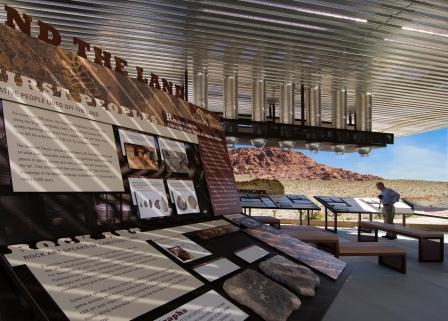 The LEED gold-certified visitor center is designed to encourage stewardship for public land by providing an outdoor experience that instills a sense of personal responsibility.
The LEED gold-certified visitor center is designed to encourage stewardship for public land by providing an outdoor experience that instills a sense of personal responsibility.The majority of the innovative interpretive exhibits are outside with four themed elements: earth, air, fire and water. If you are eager to see desert tortoises or learn more about Red Rock’s geology, head toward the Earth exhibit. Looking for a dust devil? Head to the air exhibit to create one yourself. Many people think this area is roasting hot in the summer; come to fire exhibit to learn about agave roasting pits. The water exhibit will remind you of how precious this resource is in the desert.
The indoor portion of the visitor center includes a reception desk staffed by helpful employees and volunteers who can answer your questions, a million-dollar view of the Calico Hills, touch screen exhibits, classroom and gift shop.
When the original visitor center – which is now the administrative building – opened in 1982, about 20,000 people visited Red Rock each year. Now more than a million people a year visit the area. To address this issue, the Secretary of the Interior approved funds under the Southern Nevada Public Land Management Act to build a new visitor center to provide enhanced visitor services to the increasing number of people who visit the National Conservation Area each year.
- For Teachers and Parents
-
Teacher Resources - This link provides teachers with information and resources about Red Rock Canyon the surrounding area and general teaching aids.
- For Kids
-
Color Nevada Wild - A coloring book published by the Nevada Department of Wildlife.
Virtual Junior Ranger Red Rock Canyon - Program and activity book to learn about Red Rock Canyon National Conservation Area and become a Junior Ranger. (Please be patient during download, the file size is large.)
Jóvenes Guardabosques del Cañón Red Rock
Junior Ranger Geology and Fossils - Activity book focusing on geology and fossils.
Junior Ranger Wild Horses and Burros - Activity book on how they became living symbols of the American West.
My Public Lands Citizen Science Junior Ranger Activity Book
Native Plants Junior Ranger Activity Book
Wildlife & Habitat Junior Ranger Activity Book
Wilderness 50th Anniversary Junior Ranger Activity Book
California Trails Interpretive Center Junior Ranger Activity Book
- Volunteer
-
Volunteering is an American tradition that has made immeasurable contributions to communities, organizations, and individuals throughout the country.
Your contribution of time and energy will help us to protect the magnificent natural and cultural areas entrusted to us, and you’ll go home with a sense of pride at having participated in something worthwhile.
Red Rock Canyon National Conservation Area is a part of your public land to help take care of and cherish.
Individuals, families, and organized groups are welcome to volunteer. Many opportunities are available for persons who are beginners to the highly skilled professional as well as opportunities for short term and long-term commitments. Volunteering at Red Rock Canyon can be challenging and rewarding.
What are the benefits?
- You get to meet new people with the same interests.
- You get to learn about the desert environment so close to the city that we live.
- Free training on subjects such as geology, plant, animals, and native peoples.
- Best of all you get to play outside.
- BLM volunteers have the same benefits as federal government employees for compensation for work-related injuries and tort claims protection. Although volunteers contribute their services without pay, they may deduct out-of-pocket expenses on income tax returns within the limits set by tax laws. Deductions can include car mileage, meals and lodging expenses incurred as a result of volunteer work.
The only areas which prohibit volunteers are law enforcement, fire suppression, and participating on special use flights.
A few volunteer opportunity examples are:
- Information Desk
- Tortoise Habitat Monitor
- Trail Monitor
- Natural Resource Team
- Landscape Team
If you have an interest in volunteering your time and expertise to Red Rock Canyon, please contact the Volunteer Coordinator at (702) 515-5313.
- Partnerships
-
Enjoying your visit to Red Rock Canyon National Conservation Area? We are fortunate to have agreements with the following partner organizations that made a positive impact on your visit:
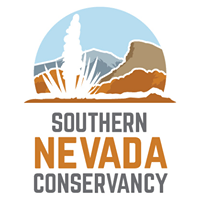 The mission of the Southern Nevada Conservancy is “to enhance the recreational, educational and interpretive programs of the Bureau of Land Management, and other governmental agencies, by providing materials and services to the public which promote an understanding and appreciation of the natural history, cultural history and sciences of Southern Nevada and specifically, Red Rock Canyon National Conservation Area.” This is done via interpretation and education, sales, fee station staffing, professional and financial support.
The mission of the Southern Nevada Conservancy is “to enhance the recreational, educational and interpretive programs of the Bureau of Land Management, and other governmental agencies, by providing materials and services to the public which promote an understanding and appreciation of the natural history, cultural history and sciences of Southern Nevada and specifically, Red Rock Canyon National Conservation Area.” This is done via interpretation and education, sales, fee station staffing, professional and financial support.Interpretation and Education
- Guided Hikes and Programs: SNC interpretive staff work hand-in-hand with BLM staff in presenting programs to school groups and the general public at Red Rock Canyon. Though SNC staff always lend a helping hand with visiting school programs, they shine in offering a variety of activities to our visitors. This can include hikes, tabletop presentations and programs on astronomy, geology and cultural history. Classes such as sketching and jewelry making round out their contribution.
- Off-Site Education: Special programs are available for schools and community organizations. For example, SNC is working with local school students on an insect inventory of Red Rock Canyon. Programs are available for other groups, including senior living centers and at-risk youth.
- Professional and Financial Support: SNC provides support in many ways, including the design and purchase of interpretive signs, planning costs, trail creation and other projects.
Elements Gift Shop
All net proceeds from purchases at the Elements gift shop support a wide variety of programs and activities at Red Rock Canyon. Items offered include books, souvenirs, gifts and creations from local artists.Fee Station
Through an assistance agreement with the BLM, SNC staffs the entrance station to Red Rock Canyon.The mission for Friends of Red Rock Canyon (FORCC) is “the preservation, protection and enrichment of Red Rock Canyon National Conservation Area, Las Vegas, Nevada.” FORRC’s main purpose is to assist the Bureau of Land Management in developing and supervising a volunteer program at the Red Rock. Members volunteer thousands of hours each year assisting with graffiti removal, community volunteer events, trash pickup, trail maintenance, leading hikes, maintaining the visitor center grounds, staffing the information desk, monitoring cultural sites and other tasks. Fund-raising efforts include:
- Dedication Walkway: Sandstone tiles can be personalized with the names of loved ones and placed in an area near the visitor center.
- License Plates: FORRC receives yearly tax-deductible donations from the sales and renewals of a Nevada Department of Motor Vehicles license plate depicting Red Rock.
- Membership: Membership with the Friends of Red Rock Canyon provides support of education and environmental programs at Red Rock.
Other activities include an annual photo contest, administering a transportation grant program to bring school children to Red Rock, providing financial support of graffiti removal and organizing trained volunteers to work in our desert tortoise habitat.
- Contact Numbers
-
Mailing Address
Red Rock Canyon National Conservation Area
1000 Scenic Loop
Las Vegas, NV 89161-1202Red Rock Canyon Main Information Line
702-515-5350Emergency or Fire
702-293-8932 or 911Sign-up for Hikes and Programs
702-515-5367Gift shop and Bookstore
702-515-5379Reservations for Scenic Drive Timed Entry, Campsites and Group Picnic Area
877-444-6777Commercial, Weddings, Large Groups Competitive Events and Vending Permits
702-515-5371Film and All Photography for Commercial Uses
702-515-5399/5381Volunteer Coordinator
702-515-5313Friends of Red Rock Canyon
702-515-5360Southern Nevada Conservancy
702-515-5367BLM Southern Nevada District Office
702-515-5000

